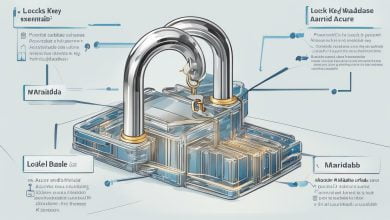
Technology has transformed the way we approach identity verification, and biometric authentication is at the forefront of this shift. Biometric authentication is a modern security measure that uses an individual’s unique physical traits, such as their fingerprints, facial features, or voice patterns, to verify their identity. This technology provides more personalized and secure identity verification solutions, thus enhancing overall security measures.
The use of biometric technology in authentication has become increasingly popular in recent years due to its many advantages. Biometric authentication provides a more secure method of identity verification as it requires the individual’s personal physical traits, which cannot be easily duplicated or stolen. In addition, it provides a faster and more convenient method of authentication, eliminating the need for passwords or pins to be remembered.
Key Takeaways
- Biometric authentication uses an individual’s unique physical traits for identity verification.
- Biometric authentication provides a more secure and personalized method of identity verification.
- Advancements in biometric technology have made it more accessible and efficient.
- Biometric authentication eliminates the need for passwords or pins, making it faster and more convenient.
The Power of Biometric Authentication Systems
Biometric authentication systems are rapidly gaining popularity in the world of security. These systems have the power to enhance security measures significantly, providing a more reliable and secure identity verification solution compared to traditional authentication methods.
Biometric authentication systems work by capturing unique physical or behavioral characteristics of an individual, such as fingerprints, iris scans, voice patterns, or facial features. These characteristics are then stored in a database and used to verify the identity of individuals when they attempt to access a secure location, device, or system.
The different types of biometric authentication methods include facial recognition, fingerprint recognition, iris recognition, voice recognition, and behavioral biometrics. Each of these methods has its advantages and disadvantages, depending on the specific security requirements.
Facial recognition, for example, is gaining popularity in airports and other public spaces as a means of identifying and apprehending potential threats. Fingerprint recognition, on the other hand, is commonly used in smartphones and other devices, providing quick and convenient access to secure data. Voice recognition is also used in call centers to authenticate the identity of callers, while iris recognition is commonly used in high-security environments such as data centers and government agencies.
The effectiveness of biometric authentication systems in enhancing security measures cannot be overstated. Since biometric characteristics are unique to each individual, it is virtually impossible for someone to impersonate another person successfully. Furthermore, biometric authentication systems can prevent identity theft, unauthorized access, and other security risks, providing a more reliable and secure solution compared to traditional authentication methods.
As businesses and organizations continue to increase their focus on security, we can expect to see even more usage of biometric authentication systems to enhance security measures. In the next section, we will explore the advancements in biometric technology and its role in the future of identity verification.
Biometric Technology: The Future of Identity Verification
The future of identity verification lies in the use of biometric technology. Biometric authentication methods offer a reliable and secure way of verifying identity, and advancements in biometric technology are making it more accessible than ever before.
Biometric authentication methods, such as fingerprint scanning, facial recognition, and iris scanning, are becoming increasingly popular due to their accuracy and convenience. These features make it easy for people to access their personal information securely and efficiently, without having to remember complex passwords or carry physical identification documents.
One of the most significant features of biometric authentication is the ability to store and match unique biological traits. Biometric authentication features, such as liveness detection and anti-spoofing technology, ensure that these traits are genuine and prevent fraudulent activity.
As biometric technology continues to evolve, we will see a shift towards more sophisticated and multimodal biometric systems. These systems will combine multiple biometric authentication methods to enhance security measures and to provide a higher level of personal identity verification.
While privacy concerns and false acceptance rates remain challenges in biometric authentication, ongoing research in the field is working towards optimizing these systems. As these issues are addressed, biometric technology will become an even more essential component of our digital lives.
Enhancing Security with Biometrics
Biometrics in security is becoming increasingly popular due to its numerous advantages. One of the main benefits of biometric authentication is its ability to prevent identity theft and unauthorized access. This is because biometric technology uses unique physical or behavioral characteristics to verify a person’s identity, such as fingerprints, facial recognition, and voice recognition.
Using biometrics in authentication also eliminates the need for passwords or PINs, which can be easily forgotten, stolen, or shared. This enhances security measures by reducing the risk of hacking and phishing attacks. Additionally, biometric technology is more convenient and time-efficient, reducing the need for manual authentication processes.
Another advantage of biometrics in security is its accuracy and reliability. Biometric authentication systems have a low false acceptance rate, meaning that the likelihood of someone being falsely identified as an authorized user is minimal. This is because the biometric features used for authentication are unique to each individual and cannot be replicated.
Overall, the use of biometric technology in security provides a more secure, convenient, and reliable method of identity verification. As the demand for enhanced security measures increases, the adoption of biometric authentication systems will only continue to grow.
Overcoming Challenges in Biometric Authentication
Despite the many advantages of biometric authentication, it is not without its challenges. One major issue is the false acceptance rate, which occurs when the system incorrectly identifies an unauthorized user as an authorized one. This can result in security breaches and compromised data.
Another concern is privacy. Biometric data is highly personal and sensitive, and users may not feel comfortable sharing it with service providers or authorities. Additionally, there have been cases of biometric data breaches, which can have serious consequences for individuals and organizations.
Continuous research and development
However, the good news is that the biometric technology industry is constantly evolving, and researchers and developers are working to overcome these challenges. For example, advancements in machine learning and artificial intelligence are helping to improve accuracy rates and reduce false acceptance.
Privacy concerns are also being addressed through the implementation of stronger security protocols and encryption methods to protect biometric data. Additionally, there are efforts to standardize biometric authentication practices and create guidelines for proper data collection, storage, and use.
The future of biometric authentication
As biometric technology continues to advance, it is expected to become an even more integral part of our daily lives. Multimodal biometric systems, which combine different types of biometric authentication methods, are already being developed to enhance security measures.
Continuous authentication, which allows for ongoing user identification throughout a session, is also a promising trend in biometric technology. With the integration of artificial intelligence and machine learning, biometric authentication is becoming more adaptive and intuitive, making it an even more effective security measure for protecting data and personal information.
Biometric Authentication in Everyday Life
Biometric authentication has become increasingly prevalent in our daily lives as a secure and convenient way to verify our identities. One example of this can be seen in smartphones, where fingerprint and facial recognition technologies have replaced traditional passcodes for unlocking devices. Not only does this provide greater security for personal information, but it also offers a more user-friendly experience.
Another industry that has embraced biometric authentication is banking. Many banks now offer biometric authentication solutions for accessing accounts, such as voice recognition or fingerprint scanning. This adds an extra layer of security to prevent unauthorized access and protects customers from identity theft.
In healthcare, biometric authentication is being used for patient verification and record keeping. This technology ensures that only authorized personnel have access to sensitive medical information, improving patient privacy and reducing the risk of data breaches.
Biometric authentication is also being utilized in transportation systems, such as airports and public transportation, to enhance security measures and speed up the verification process.
Overall, biometric authentication is becoming an increasingly important aspect of our daily lives, providing a secure and user-friendly way to verify our identities. As technology continues to advance, we can expect to see even more widespread use of biometric authentication in a variety of industries.
The Future of Biometrics: Evolving Security Measures
Biometric technology has come a long way since its inception, and it continues to evolve at a rapid pace. With the shift towards biometrics in authentication, it’s clear that the future of identity verification lies in more secure and personalized systems.
One emerging trend in biometric technology is multimodal biometric systems. These systems combine different biometric modalities such as facial recognition and fingerprint scanning to create a more robust identity verification process. This approach can improve accuracy and reduce the risk of false positives or false negatives.
Continuous authentication is another promising trend in biometrics. Rather than requiring a single verification step at login, continuous authentication continuously monitors the user’s biometric data to ensure that the user is who they claim to be. This approach can improve security and make it more difficult for fraudsters to gain access to sensitive data.
Artificial intelligence is also being integrated into biometric technology. AI algorithms can improve accuracy and speed up the identification process, making biometric authentication even more efficient and secure.
As biometric technology continues to advance, we can expect to see even more innovative and secure solutions for identity verification. It’s clear that the shift towards biometrics is not just a passing trend, but rather a fundamental change in the way we approach security.
Conclusion: The Potential of Biometrics in Authentication
Biometric authentication is rapidly changing the way we verify our identities. As technology evolves, we are shifting towards more personal and secure methods of authentication. The advantages of biometric technology are clear, with features such as fingerprint scanning, facial recognition, and iris scanning providing reliable and accurate identification.
Our everyday lives are becoming increasingly reliant on biometric authentication systems, with smartphones, banking, and healthcare industries utilizing this technology for secure identity verification. The potential for biometrics is enormous, with continuous advancements in the field enabling more sophisticated and reliable authentication methods.
The Future of Biometrics
As biometric technology evolves, we can expect to see new forms of authentication emerging. Multimodal biometric systems, using a combination of different biometric methods, are increasing in popularity. Continuous authentication, utilizing machine learning and artificial intelligence, is allowing for seamless and secure identity verification experiences.
The future of biometrics is bright, with the potential to revolutionize the way we verify our identities. As we shift towards more secure and convenient methods of authentication, biometric technology will play a large role in protecting our sensitive information and preventing identity theft.
Overall, the potential of biometrics in authentication is vast. With ongoing research and development, we can expect to see even more sophisticated and reliable methods of identity verification emerging in the years to come.
FAQ
Q: What is biometric authentication?
A: Biometric authentication is a method of verifying an individual’s identity using unique biological characteristics, such as fingerprints, iris patterns, or voiceprints.
Q: What are the advantages of biometrics in authentication?
A: Biometrics offer enhanced security as they are based on unique physical or behavioral traits that are difficult to replicate. They also provide convenience as individuals do not need to remember passwords or carry physical identification.
Q: How do biometric authentication systems work?
A: Biometric authentication systems capture and store an individual’s biometric data. When authentication is required, the system compares the provided biometric sample (e.g., fingerprint or facial scan) with the stored template to verify the individual’s identity.
Q: What types of biometric authentication methods are there?
A: Some common types of biometric authentication methods include fingerprint recognition, facial recognition, iris scanning, voice recognition, and palm vein authentication.
Q: Can biometric authentication prevent identity theft?
A: Biometric authentication adds an extra layer of security and makes it significantly more challenging for fraudsters to impersonate individuals. This reduces the risk of identity theft compared to traditional authentication methods like passwords.
Q: Are there any challenges in biometric authentication?
A: Yes, there are challenges such as false acceptance rates (where the system incorrectly verifies an impostor) and privacy concerns related to the storage and use of biometric data. However, ongoing research and advancements in biometric technology aim to address these challenges.
Q: How is biometric authentication used in everyday life?
A: Biometric authentication is increasingly used in smartphones for unlocking devices and authorizing payments. It is also employed in industries like banking, healthcare, and government for secure identity verification and access control.
Q: What does the future hold for biometrics?
A: The future of biometrics is promising, with trends such as multimodal biometric systems (combining multiple biometric traits), continuous authentication (monitoring biometrics throughout a session), and the integration of artificial intelligence to enhance accuracy and security.








